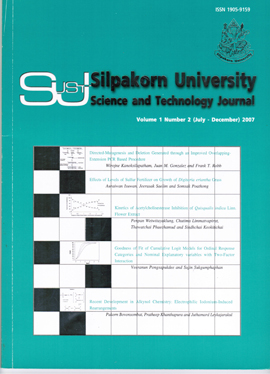Kinetics of Acetylcholinesterase Inhibition of Quisqualis indica Linn. Flower Extract
Main Article Content
Abstract
Rangoon creeper (Quisqualis indica Linn.) is a plant of the family Combretaceae. In Thai traditionalmedicine, its seeds contain oil and quisqualic acid that act as anthelminthic. Its flowers are used against diarrheaand eaten as vegetable. The flower extract gave high total polyphenol contents and showed strong antioxidantactivity. In the search for new acetylcholinesterase inhibitors from plant origin, it was demonstrated that methanolicextract of Q. indica flower exhibited this activity. The extract inhibited electric eel acetylcholinesterase in dosedependent manner with an IC50 value of 0.77 μg/ml. The Michaelis-Menten constant (Km) for the hydrolysisof acetylthiocholine iodide was 0.034 mM. The Km value in the presence of the extracts (Kmapp) at firstdecreased, and then increased by 60-88.9%. The Vmax was 0.017 μM/min/μg protein. The Vmax value in the presence of the extracts (Vmaxapp) decreased by 2.8-52.3%. The estimated value of KI was 1.41 mM, respectively. The Lineweaver-Burk plot, Dixon plot and their replots showed combination of the mixed and partially noncompetitive inhibition.
Downloads
Article Details
References
Alexopoulos, G. S., Jeste, D. V., Chung, H., Carpenter, D., Ross, R., and Docherty, J. P. (2005). The expert consensus guideline series. Treatment of dementia and its behavioral disturbances. Introduction: methods, commentary, and summary. Journal of Postgraduate Medicine Spec No: 6-22.
Alhomida, A. S., Al-Rajhi, A. A., Kamal, M. A., and Al-Jafari, A. A. (2000). Kinetic analysis of the toxicological effect of Tacrine (Cognex®) on human retinal acetylcholinesterase activity. Toxicology, 147: 33-39.
Bisswanger, H. (2002). Enzyme kinetics. In Enzyme Kinetics: Principles and Methods, WILEY-VCH verlag GmbH, Weinheim, Germany.
Bradford, M. M. (1976). A rapid and sensitive method for the quantitation of microgram quantities of protein utilizing the principle of protein-dye binding. Analytical Biochemistry, 72: 248-254.
Brill, H. C. and Wells, A. H. (1971). The physiological active constituents of certain Philippine medicinal plants II. The Philippine Journal of Sciences, 2: 16-95.
Brossi, A., Schoenenberger, B., Clark, O. E., and Ray, R. (1986). Inhibition of Acetylcholinesterase from Electric Eel by (-)- and (+)- Physostigmine and Related Compounds. Federation of European Biochemical Societies, 201(2): 190-192.
Chivapat, S., Chavalittumrong, P., and Chuntapet, P. (1998). Study on toxicity of Quisqualis indica Linn. seed. Bulletin of Department of Medical Sciences, 40(1): 9-21.
Coulthard, E., Singh-Curry, V., and Husain, M. (2006). Treatment of attention deficits in neurological disorders. Current Opinion in Neurology, 19(6): 613-8.
Ellman, G. L., Courtney, D., Andres, V. Jr., and Featherstone, R. M. (1961). A new and rapid colorimetric determination of acetylcholinesterase activity. Biochemical Pharmacology, 7: 88-95.
Funda, H., Tanaka, T., Kaijima, M., Nakai, H., and Yonemasu, Y. (1985). Quisqualic acid-induced hippocampal seizures in unanesthetized cats. Neuroscience Letters, 59(1): 53-60.
Giacobini, E. (1997). From molecular structure to Alzheimer therapy. The Japanese Journal of Pharmacology, 74: 225-241.
Ishizaki, T., Kato, K., Kumada, M., et al. (1973). Effect of quisqualic acid upon Ascaris suum in vitro in comparison with those of kainic acid, alphar-allokainic acid and pyrantel palmoate. Japanese Journal of Parasitology, 22(4): 181-186.
Ji, H.-F. and Zhang, H.-Y. (2006). Theoretical evaluation of flavonoids as multipotent agents to combat Alzheimer’s disease. Journal of Molecular Structure: THEOCHEM, 767: 3-9.
Kamal, M. A., Greig, N. H., Alhomida, A. S., and Al-Jafari, A. A. (2000). Kinetics of Human Acetylcholinesterase Inhibition by the Novel Experimental Alzheimer Therapeutic Agent, Tolserine. Biochemical Pharmacology, 60: 561-570.
Kaijima, M., Tanaka, T., and Yonemasu, Y. (1987). Epileptogenic properties of quisqualic acid: microinjection into the unilateral amygdala in cats. Brain Nerve (Tokyo), 39(10): 971-974.
Kim, H. K., Kim, M., Kim, S., et al. (2004). Effects of green tea polyphenol on cognitive and acetylcholinesterase activities. Bioscience Biotechnology and Biochemistry, 68(9): 1977-1979.
Kumazawa, S., Taniguchi, M., Suzuki, Y., et al. (2002). Antioxidant activity of polyphenols in Carob Pods. Journal of Agricultural and Food Chemistry, 50: 373-377.
Limmatvapirat, C., Phaechamud, T., and Keokitichai, S. (2006). The Total Polyphenol Content of some Edible Flowers of Thailand. In Proceeding of the 21st Congress of Federation of Asian Pharmaceutical Associations, 18-21 Nov, Yokohama, Japan. p.288.
Rickwood, C. J. and Galloway, T. S. (2004). Acetylcholinesterase inhibition as a biomarker of adverse effect. A study of Mytilus edulis exposed to the priority pollutant chlorfenvinphos. Aquatic Toxicology, 67(1): 45-56.
Rondouin, G., Lerner-Natoil, M., and Hashizume, A. (1987). Wet dog shakes in limbic versus generalized seizures. Experimental Neurology, 95(2): 500-505.
Silverstein, F. S., Chen, R., and Johnston, M. V. (1986). The glutamate analogue, quisqualic acid in neurotoxic in stratum and hippocampus of immature rat brain. Neuroscience Letters, 71(1): 13-18.
Soreq, H. and Seidman, S. (2000). Anti-sense approach to anticholinesterase therapeutics. The Israel Medical Association. Suppl: 81-5.
Wetwitayaklung, P., Phaechamud, T., and Keokitichai, S. (2007). The study of antioxidant activities of edible flower. In Proceeding of International Workshop on Medicinal and aromatic Plants, 15-18 Jan, Chiang Mai, Thailand. p.75.
Zaczek, R. and Coyle, J. T. (1982) Excitatory amino acid analogs: Neurotoxicity and seizures. Neuropharmacology, 21(1): 15-26.
Zarotsky, V., Sramek, J. J., and Cutler, N. R. (2003). Galantamine hydrobromide: an agent for Alzheimer’s disease. American Journal of Health-System Pharmacy, 60: 446-452.


